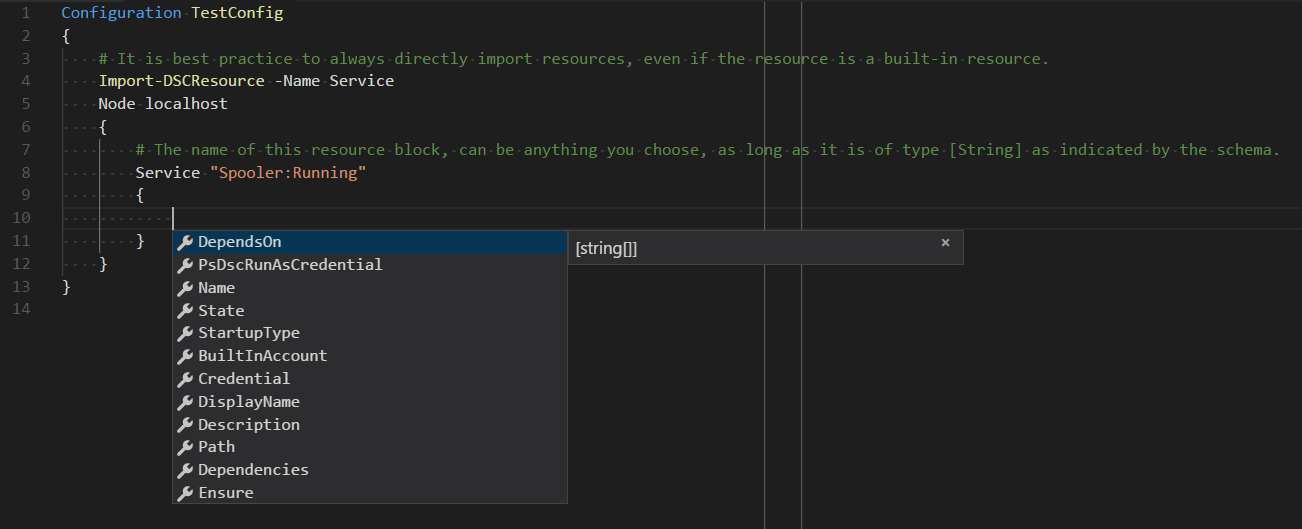DSC Resources
Applies to Windows PowerShell 4.0 and up.
Overview
Desired State Configuration (DSC) Resources provide the building blocks for a DSC configuration. A resource exposes properties that can be configured (schema) and contains the PowerShell script functions that the Local Configuration Manager (LCM) calls to "make it so".
A resource can model something as generic as a file or as specific as an IIS server setting. Groups of like resources are combined in to a DSC Module, which organizes all the required files in to a structure that is portable and includes metadata to identify how the resources are intended to be used.
Each resource has a *schema that determines the syntax needed to use the resource in a Configuration. A resource's schema can be defined in the following ways:
Schema.Moffile: Most resources define their schema in aschema.moffile, using Managed Object Format.<Resource Name>.schema.psm1file: Composite Resources define their schema in a<ResourceName>.schema.psm1file using a Parameter Block.<Resource Name>.psm1file: Class based DSC resources define their schema in the class definition. Syntax items are denoted as Class properties. For more information, see about_Classes.
To retrieve the syntax for a DSC resource, use the Get-DSCResource cmdlet with the Syntax parameter. This usage is similar to using Get-Command with the Syntax parameter to get cmdlet syntax. The output you see will show the template used for a resource block for the resource you specify.
Get-DscResource -Syntax Service
The output you see should be similar to the output below, though this resource's syntax could change in the future. Like cmdlet syntax, the keys seen in square brackets, are optional. The types specify the type of data each key expects.
Note
The Ensure key is optional because it defaults to "Present".
Service [String] #ResourceName
{
Name = [string]
[BuiltInAccount = [string]{ LocalService | LocalSystem | NetworkService }]
[Credential = [PSCredential]]
[Dependencies = [string[]]]
[DependsOn = [string[]]]
[Description = [string]]
[DisplayName = [string]]
[Ensure = [string]{ Absent | Present }]
[Path = [string]]
[PsDscRunAsCredential = [PSCredential]]
[StartupType = [string]{ Automatic | Disabled | Manual }]
[State = [string]{ Running | Stopped }]
}
Note
In PowerShell versions below 7.0, Get-DscResource does not find Class based DSC resources.
Inside a Configuration, a Service resource block might look like this to Ensure that the Spooler service is running.
Note
Before using a resource in a Configuration, you must import it using Import-DSCResource.
Configuration TestConfig
{
# It is best practice to always directly import resources, even if the
# resource is a built-in resource.
Import-DSCResource -Name Service
Node localhost
{
# The name of this resource block, can be anything you choose, as l
# ong as it is of type [String] as indicated by the schema.
Service "Spooler - Running"
{
Name = "Spooler"
State = "Running"
}
}
}
Configurations can contain multiple instances of the same resource type. Each instance must be uniquely named. In the following example, a second Service resource block is added to configure the "DHCP" service.
Configuration TestConfig
{
# It is best practice to always directly import resources, even if the
# resource is a built-in resource.
Import-DSCResource -Name Service
Node localhost
{
# The name of this resource block, can be anything you choose, as
# long as it is of type [String] as indicated by the schema.
Service "Spooler - Running"
{
Name = "Spooler"
State = "Running"
}
# To configure a second service resource block, add another Service
# resource block and use a unique name.
Service "DHCP - Running"
{
Name = "DHCP"
State = "Running"
}
}
}
Note
Beginning in PowerShell 5.0, IntelliSense was added for DSC. This new feature allows you to use TAB and Ctr+Space to auto-complete key names.

Types of resources
Windows comes with built in resources and Linux has OS specific resources. There are resources for cross-node dependencies, package management resources, as well as community owned and maintained resources. You can use the above steps to determine the syntax of these resources and how to use them. The pages that serve these resources have been archived under Reference.
Windows built-in resources
- Archive Resource
- Environment Resource
- File Resource
- Group Resource
- GroupSet Resource
- Log Resource
- Package Resource
- ProcessSet Resource
- Registry Resource
- Script Resource
- Service Resource
- ServiceSet Resource
- User Resource
- WindowsFeature Resource
- WindowsFeatureSet Resource
- WindowsOptionalFeature Resource
- WindowsOptionalFeatureSet Resource
- WindowsPackageCabResource Resource
- WindowsProcess Resource
Cross-Node dependency resources
Package Management resources
Linux resources
Feedback
Coming soon: Throughout 2024 we will be phasing out GitHub Issues as the feedback mechanism for content and replacing it with a new feedback system. For more information see: https://aka.ms/ContentUserFeedback.
Submit and view feedback for
